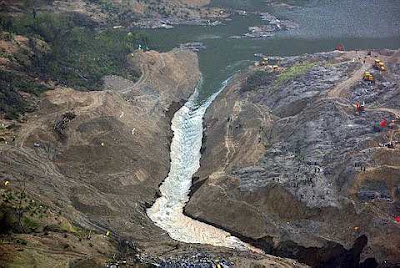
An aerial view shows the sluice channel at the Tangjiashan quake-formed lake in southwest China's Sichuan Province, June 9, 2008, in this picture distributed by China's official Xinhua News Agency. Picture taken June 9, 2008.

Rushing water from a "quake lake" flows through the earthquake-devastated city of Beichuan, about 150 km (93 miles) north of Chengdu in Sichuan province, June 10, 2008. Muddy lake water from the dangerously unstable Tangjiashan quake lake, formed by China's most devastating earthquake in decades, rushed into Beichuan on Tuesday, covering about a third of the settlement where the water level was rising fast.

Rushing water from a "quake lake" flows through the earthquake-devastated city of Beichuan, about 150 km (93 miles) north of Chengdu in Sichuan province, June 10, 2008. Muddy lake water from the dangerously unstable Tangjiashan quake lake, formed by China's most devastating earthquake in decades, rushed into Beichuan on Tuesday, covering about a third of the settlement where the water level was rising fast.

Boats are seen on the dried-up riverbed of the Tongkou river, downstream from the Tangjiashan quake lake, in the earthquake-hit Tongkou town of Beichuan, Sichuan province, June 9, 2008. Floodwaters could reach the town within an hour if the Tangjiashan quake lake bursts, local patrolling soldiers said.

Workers pile up stones to build a temporary road as the Anzhou Bridge behind has become unsafe after the recent earthquake and aftershocks at Ankang Town in Anxian County, Sichuan province June 9, 2008.

An aerial view shows the drainage of the Tangjiashan quake lake in southwest China's Sichuan province June 10, 2008. Muddy lake water from the dangerously unstable Tangjiashan quake lake, formed by China's most devastating earthquake in decades, rushed into the quake-hit Chinese town of Beichuan on Tuesday, covering about a third of the settlement where the water level was rising fast.

Rushing water from a "quake lake" flows through the earthquake-devastated city of Beichuan, Sichuan province, June 10, 2008. Muddy lake water from the dangerously unstable Tangjiashan quake lake, formed by China's most devastating earthquake in decades, rushed into Beichuan on Tuesday, covering about a third of the settlement where the water level was rising fast.

An aerial view shows the drainage of the Tangjiashan quake lake in southwest China's Sichuan province, June 10, 2008, in this picture distributed by China's official Xinhua News Agency.

Rushing water from a "quake lake" flows through the earthquake-devastated city of Beichuan, Sichuan province, June 10, 2008. Muddy lake water from the dangerously unstable Tangjiashan quake lake, formed by China's most devastating earthquake in decades, rushed into Beichuan on Tuesday, covering about a third of the settlement where the water level was rising fast.

An aerial view shows the drainage of the Tangjiashan quake lake in southwest China's Sichuan province, June 10, 2008, in this picture distributed by China's official Xinhua News Agency.

Water from a "quake lake" rushes through the earthquake-devastated city of Beichuan, located around 150 km (93 miles) north of Chengdu in Sichuan Province, June 10, 2008. Local witnesses said water levels in the river running through Beichuan rose dramatically this morning after People's Liberation Army (PLA) soldiers continued yesterday to try and ease the pressure on swollen "quake lakes" located above the town. More than 30 quake lakes formed when the May 12 earthquake triggered landslides that blocked rivers, raising fears of a secondary disaster after the tremor that killed more than 69,000.

Evacuated residents watch from high ground rushing water from a "quake lake" flowing down the Fujiang River near the earthquake-affected city of Jiangyou, located around 130 km (81 miles) north of Chengdu in Sichuan Province, June 10, 2008. Local witnesses said water levels in the river rose dramatically this morning after People's Liberation Army (PLA) soldiers continued yesterday to try and ease the pressure on swollen "quake lakes" located upstream. More than 30 quake lakes formed when the May 12 earthquake triggered landslides that blocked rivers, raising fears of a secondary disaster after the tremor that killed more than 69,000.

Water flows from the Tangjiashan quake lake in southwest China's Sichuan province June 10, 2008. Muddy lake water from the dangerously unstable Tangjiashan quake lake, formed by China's most devastating earthquake in decades, rushed into the quake-hit Chinese town of Beichuan on Tuesday, covering about a third of the settlement where the water level was rising fast.

An aerial view shows the drainage of the Tangjiashan quake lake in southwest China's Sichuan province June 10, 2008. Muddy lake water from the dangerously unstable Tangjiashan quake lake, formed by China's most devastating earthquake in decades, rushed into the quake-hit Chinese town of Beichuan on Tuesday, covering about a third of the settlement where the water level was rising fast.

An aerial view shows the drainage of the Tangjiashan quake lake in southwest China's Sichuan province June 10, 2008. Muddy lake water from the dangerously unstable Tangjiashan quake lake, formed by China's most devastating earthquake in decades, rushed into the quake-hit Chinese town of Beichuan on Tuesday, covering about a third of the settlement where the water level was rising fast.





